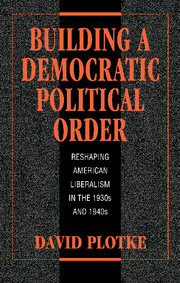Book contents
- Frontmatter
- Contents
- Preface
- Introduction: The Democratic order as a political project
- 1 When does politics change?
- 2 Creating political orders: the logic of the Democratic experience
- 3 Democratic opportunities in the crises of the 1930s
- 4 Passing the Wagner Act and building a new Democratic state
- 5 Party and movements in the Democratic upsurge, 1935–7
- 6 Progressive liberalism as pragmatic common sense
- 7 Surprising years: electing Truman and sustaining the Democratic order, 1947–9
- 8 Passing Taft-Hartley: what the losers won (and what the winners lost)
- 9 New political fronts? growth and civil rights in the 1940s
- 10 Democratic anti-Communism and the Cold War
- 11 From Truman to Kennedy: the reach and limits of Democratic power
- 12 Was the Democratic order democratic?
- Index
5 - Party and movements in the Democratic upsurge, 1935–7
Published online by Cambridge University Press: 17 September 2009
- Frontmatter
- Contents
- Preface
- Introduction: The Democratic order as a political project
- 1 When does politics change?
- 2 Creating political orders: the logic of the Democratic experience
- 3 Democratic opportunities in the crises of the 1930s
- 4 Passing the Wagner Act and building a new Democratic state
- 5 Party and movements in the Democratic upsurge, 1935–7
- 6 Progressive liberalism as pragmatic common sense
- 7 Surprising years: electing Truman and sustaining the Democratic order, 1947–9
- 8 Passing Taft-Hartley: what the losers won (and what the winners lost)
- 9 New political fronts? growth and civil rights in the 1940s
- 10 Democratic anti-Communism and the Cold War
- 11 From Truman to Kennedy: the reach and limits of Democratic power
- 12 Was the Democratic order democratic?
- Index
Summary
Your apparent unwillingness to advise the Nation [of] your attitude toward the high handed, brutal and lawless display of power exhibited by labor union leaders as expressed in the prevailing epidemic of “sit downs” leaves many of us bewildered and apprehensive. Your silence can only be construed as politically inspired and as unmindful of the evil effects of such lawlessness upon the entire population.
– R. D. Small to Roosevelt, 4/8/37When a political order has been dismantled and attempts to build a new order are underway, politics is surprising and volatile. Fluid political forces gain definition in sharp conflicts where the stakes are large and the rules uncertain. Political leadership means defining a new framework for routine politics. Such a phase occurred in the 1930s when a progressive liberal bloc built a new Democratic order. Prior Democratic forces were expanded and reshaped while new forces emerged. The Democratic order cut across and included important parts of the state, the Democratic Party, and new political forces. This chapter examines the party and movements in the Democratic triangle in 1935–7, focusing on the 1936 campaign.
Changing the Democratic Party
The Democratic Party had to change in the 1930s to make a significant contribution to creating a new political order.
- Type
- Chapter
- Information
- Building a Democratic Political OrderReshaping American Liberalism in the 1930s and 1940s, pp. 128 - 161Publisher: Cambridge University PressPrint publication year: 1996



